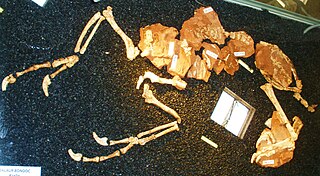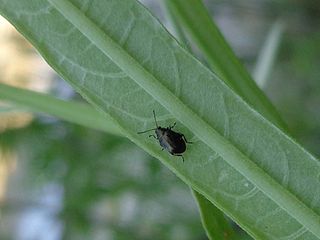This article is about the main brands of beer produced and served in Romania, also revolving around the history of this beverage on the territory of the Romanian lands, since at least the times of the Romanian Old Kingdom to contemporary times. The hereby article also focuses on the local breweries and craft beers.
Bradycneme is a genus of theropod dinosaur from the Maastrichtian-age Upper Cretaceous Sânpetru Formation of the Hațeg Basin, Transylvania, Romania. The genus contains a single species, Bradycneme draculae, known only from a partial right lower leg, which its original describers believed came from a giant owl.

Elopteryx is a genus of, perhaps troodontid, maniraptoran theropod dinosaur based on fragmentary fossils found in late Cretaceous Period rocks of Romania. The single species, Elopteryx nopcsai, is known only from very incomplete material, and therefore is considered a nomen dubium by most paleontologists.

Zalmoxes is an extinct genus of rhabdodontid ornithopod dinosaur from the Maastrichtian of Romania. The genus is known from specimens first named as the species Mochlodon robustum in 1899 by Franz Nopcsa before being reclassified as Rhabdodon robustum by him in 1915. In 1990 this name was corrected to Rhabdodon robustus by George Olshevsky, and in 2003 the species was once more reclassified, this time as the type species Zalmoxes robustus. Zalmoxes refers to the Dacian deity Zalmoxis, and robustus to the robustness of the remains. In 2003 another species was named, Zalmoxes shqiperorum, named for the Albanian name for Albanians.
Heptasteornis is the name given to a potentially dubious genus of alvarezsaurid dinosaur from the Late Cretaceous. The type species is Heptasteornis andrewsi, described as a presumed gigantic prehistoric owl in 1975. It was previously included in Elopteryx nopcsai and indeed the holotypes of both were believed to be from the same individual as they were discovered, and initially were assigned the same specimen number. This appears to be in error however.

Altica is a large genus of flea beetles in the subfamily Galerucinae, with about 300 species, distributed nearly worldwide. The genus is best represented in the Neotropical realm, well represented in the Nearctic and Palearctic, but occurs also in the Afrotropic, Indomalaya, and Australasia. The species are similar to each other, small metallic blue-green-bronze beetles, often distinguished from each other only by the aedeagus. The species of Altica, both as larvae and as adults, are phytophagous, feeding on plant foliage of various food plant taxa, specific for each Altica species. Onagraceae and Rosaceae are the dominant host plant families for Holarctic species. The adult Altica beetles are able to jump away when approached.

Ernst Csiki, Ernst Dietl or Ernő Csiki (Csíki) was a Hungarian entomologist who specialised in Coleoptera.

Cymindis is a genus of ground beetle native to the Palearctic, the Near East, and North Africa. It contains the following species:

Poecilus is a genus of ground beetle native to the Afro-tropical region, the Palearctic, the Near East, and North Africa.

Paludititan is a genus of titanosaurian sauropod dinosaur which lived in the area of present Romania during the Late Cretaceous. It existed in the island ecosystem known as Hațeg Island.

Balaur is a genus of theropod dinosaur from the late Cretaceous period, in what is now Romania. It is the type species of the monotypic genus Balaur, after the balaur, a dragon of Romanian folklore. The specific name bondoc means "stocky", so Balaur bondoc means "stocky dragon" in Romanian. This name refers to the greater musculature that Balaur had compared to its relatives. The genus, which was first described by scientists in August 2010, is known from two partial skeletons.
Norbert Csiki is a Hungarian football player who plays for Balassagyarmat.
Trichisia is a genus of beetles in the family Carabidae, containing the following species:
Cymindis elegans is a ground beetle species in the genus Cymindis, in the subfamily Lebiinae and tribe Lebiini. It is found in Virginia in the United States.

Chaetocnema is a genus of flea beetles in the family Chrysomelidae. There are some 470 described species worldwide.
Cymindis avenae is a species of ground beetle in the subfamily Harpalinae. It was described by J. R. Sahlberg in 1908.
Cymindis cribricollis is a species of ground beetle in the subfamily Harpalinae. It was described by Pierre François Marie Auguste Dejean in 1831.
Litovoi tholocephalos is a multituberculate mammal indigenous to Romania, then the Hațeg Island. A part of Kogaionidae, a lineage otherwise dominated by iron-enamelled insectivores, Litovoi appears to have had a similar lifestyle, having similar teeth. Different however is its cranial anatomy; this is the first recorded example of a Mesozoic island mammal have reduced its brain size in an insular environment, presumably due to the lack of predators or specialised niche it found itself in. It has one of the smallest brain-to-body ratios seen in derived mammals, although it retains enlarged olfactory bulbs and paraflocculi. Being relatively normal sized for a multituberculate, this showcases that brain reduction is not correlated to allometry.
Anna Júlia Csiki is a Hungarian footballer who plays as a midfielder and has appeared for the Hungary women's national team.
Transylvanosaurus is an extinct genus of rhabdodontid ornithopod dinosaur from the Late Cretaceous (Maastrichtian) Hateg Basin of Romania. The type species is Transylvanosaurus platycephalus, known from a fragmentary skull.








